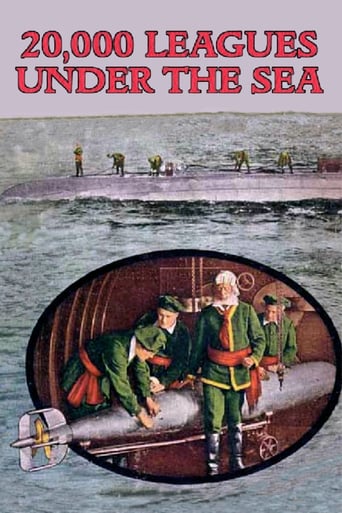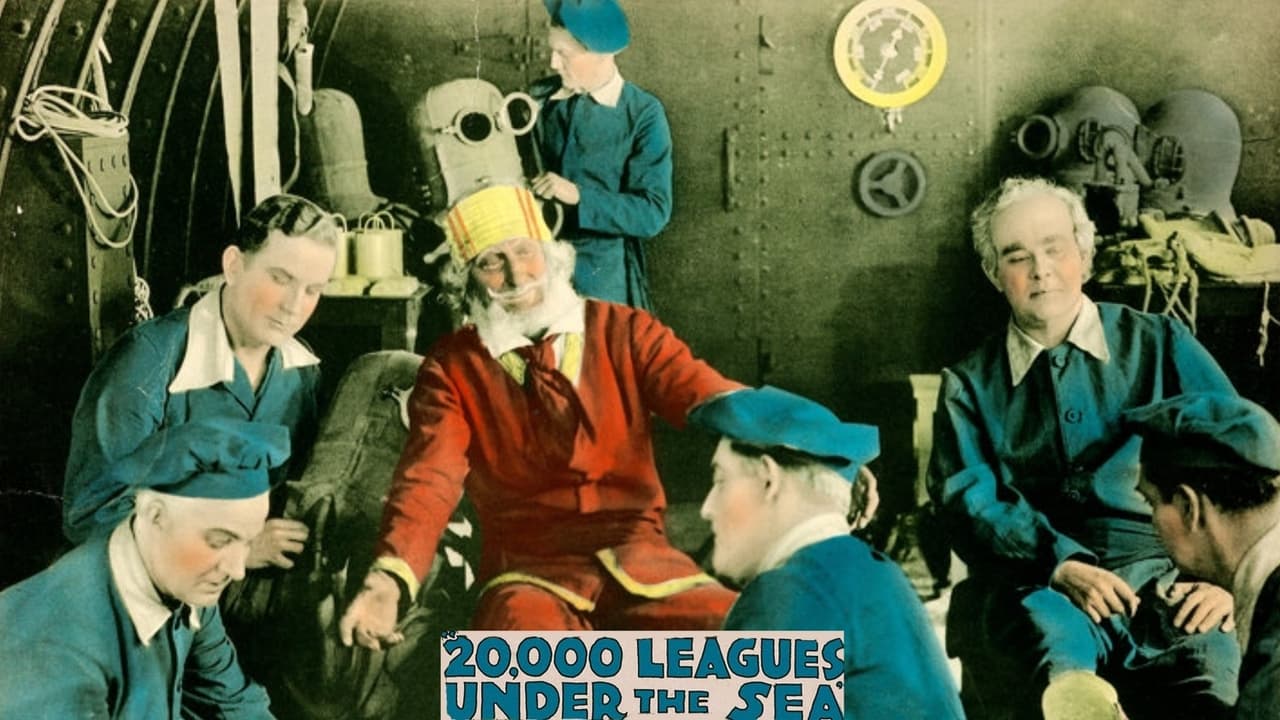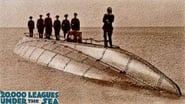Richard Chatten
A remarkably lavish production that seems not content with merely filming Jules Verne's 1870 novel but for good measure also throws in his later novel 'L'Île Mystérieuse' and a concluding flashback that - as the subtitles themselves admit - owes nothing to Verne but must have made an already expensive production needlessly extravagant (Universal's Carl Laemmle took a bath - if you'll pardon the expression - on the reported $500,000 he spent on it).The most remarkable aspect of the film is the pioneering underwater photography supervised by the brothers Ernest & George Williamson (some of it shot in the Bahamas) depicting the view from Captain Nemo's famous picture window, the camera lingering lovingly on strikingly modern-looking actuality footage of coral reefs and shoals of fish. When Nemo's crew get into their diving suits there is then remarkable footage of them interacting with actual sharks; although the realism abruptly evaporates in a later scene involving an extremely phony looking octopus.The film's makers quickly lose interest in a straight adaptation of Verne's novel at this point, and the action transfers to a mysterious desert island whose one human inhabitant is initially a boisterous 'child of nature' played by Jane Gail in dusky body makeup, who jauntily trades in her cheetah skin sarong for a fetching combination of blouse and trousers provided by one of the visitors. (Quite a few adventure films from this period that I've seen have put the leading lady in trousers.) Nemo, alias Daaker, turns out to have been an Indian prince in a previous life, and Miss Gail turns out to be his daughter, as is explained in a flashback thrown in climaxing in a native uprising. The film had at this point seemed to be drawing to its conclusion; which makes the insertion of this very expensive looking sequence reportedly featuring almost 2,000 extras all the more bewildering.The extraordinary underwater footage aside, the handsome and atmospheric look of the rest of the film probably owes more to the photography of Eugene Gaudio (whose elder brother Tony's long career at Warner Bros. included 'The Adventures of Robin Hood') than to the rather perfunctory direction of Stuart Paton, who should have told Allen Holubar as Nemo and the unidentified actress playing his late wife not to wave their arms around so much. Other reviewers have commented on the resemblance of the uniform worn by Captain Nemo and his crew to the one traditionally worn by Santa Claus.
Hitchcoc
As is the case with these early science fiction efforts, there some pretty interminable scenes for a modern viewer. The underwater hunting trip is endless, but in its time probably was quite remarkable. The interaction with the principle characters is virtually non-existent. Nemo has something going on and his submarine is known as a monster, yet he takes on board, those whose ship he destroyed. He seems intent on helping people and seems to have a good heart. Of course, the original book is thrown out the window, with a tale of a lost child and a dead wife and the pursuit of a man whom he has obsessed over. This is OK because it does bring in an interesting set of circumstances. It presents guilt and its implications. I did not see a very good print, which was distracting, but the early silent feature is quite inviting.
John W Chance
This is Carl Laemmle's color tinted two hour and twenty minute Universal production of Jules Verne's classic. If you thought Laemmle's versions of 'Dracula' (1931) and 'Frankenstein' (1921) didn't follow the novels they came from, you'll throw up your hands here. However, it is the first film to show extensive real underwater photography (shot in the Bahamas), with the aquamen actually battling live sharks. For these sequences alone, it is a must see. How they must have amazed movie patrons back in 1916! (They still amaze.) The story of Captain Nemo's tortured sorrowful soul, saddened by mankind's cruelty, and Verne's masterful prose visualization of the wonders of the oceans have been mostly thrown out in favor of a jungle girl's island rescue story, with her as Nemo's long lost daughter, and he himself an Indian prince! Talk about rewriting the book, before this last revelation there is an intertitle, "Captain Nemo reveals the tragic secret of his life, which Jules Verne never told." There are many intertitles referring to the "Mysterious Island," but it's doubtful that all of this jungle story material is from Verne's book of the same name. Of course, this is not the worst revision of a classic story. Though dozens have been made, the worst has to be Disney's 'The Little Mermaid' (1989) who doesn't die at the end, but marries the prince and lives happily ever after instead.Nemo, with his square beard and Santa Claus outfit looks like those old early twentieth drawings of 'Father Christmas.' Professor Arronax and Ned Land are cast to the side as peripheral characters. Although there is often some quick cutting, the camera hardly ever moves, as if a play is being photographed, and there are almost no close ups or medium shots. The acting is little more than the clichéd, broad, exaggerated gesturing so common to the earliest era of film making (1903-1915.) Griffith began toning it down with 'Intolerance' in 1916, but Mae Marsh in 'The Battle of Elderbush Gulch' (1914) is the equal of Jane Gail here for flighty, flippity floppity jumping and prancing around. There were films that had more creative camera-work during this decade than the deadly, static cinematography here by Eugene Gaudio; besides the work of D.W. Griffith in 'The Birth of a Nation' (1915) and 'Intolerance' (1916) there was the fantastc Italian film 'Cabiria' (1915) and some of the Chaplin shorts.The real high point of the film, of course, is the spectacular underwater photography by Geogre and Ernest Williamson, who are not only given specific mention in the opening credits, but also are shown in live action tipping their hats to the audience. All their scenes are the highlights of the film. At last a moving camera! Finally, this expanded new print (others were as short as 81 minutes) has a wonderful musical score by Brian Benison done in 1991. He wrote new scores for Stan Laurel's great 'Oranges and Lemons' (1925) as well as Douglas Fairbanks' 'The Three Musketeers' (1921).The underwater photography gets a 10, but the rest is too 1910ish, so I have to give the movie a four and half.
mlevans
This is a most intriguing and entertaining film. While some flaws can certainly be pointed out, it still stands up as a fine feature film.The story is certainly different in this version. This Nemo is a Boy Scout, helping those in need and interested in revenge only in the case of one personal enemy. As I recall from reading the book and seeing one of the color, sound versions (both about 30 years ago), Captain Nemo was a real sob, intent on extracting "revenge" on every ship he came across. (He was also about half the age of this Nemo.) Still, the twists make for an interesting story, as does the incorporation of "Mysterious Island," another Jules Verne masterpiece, into the story.Of course the film is best remembered for the amazing early underwater film sequences. These are something to see especially considering the year. My only criticism of the film would be that Paton perhaps got a little carried away with showing his sequences of underwater sights. Of course, who could blame him? No one else had put anything remotely like this on screen in a feature film before. There is almost a quasi-documentary feel to the film, thanks to the underwater scenes and early SCUBA outfits.Alan Holubar is outstanding as the aging (and the young) Captain Nemo, while the rest of the cast is solid. The only exception is Jane Gail's horrid overacting as the princess. This is strange, considering that she handled the "child of nature" role with some credibility and little if no overacting. Perhaps the female histrionics were expected in 1916. (At least Robert K. Klepper identifies Gail as playing both roles in "Silent Films, 1877-1996." IMDb does not identify the princess.)In any case, whatever flaws one may find are dwarfed by the realization that it was so advanced for its time. It's still entertaining, as well, and a great addition to any collection.


 AD
AD







